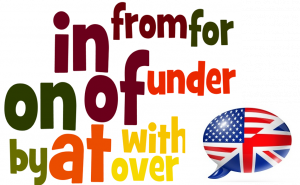Language/English/Grammar/Prepositions
Prepositions are short words (on, in, to) that usually stand in front of nouns (sometimes also in front of geund verbs).
A prepositions describes a relationship between other words in a sentences.
In itself, a word like "in" or " after" is rather meaningless and hard to define in mere words.
For instance, when you do try to define a preposition like "in" or " between" or "on", you invariably use your hands to show how something is situated in relationship to something else.
Prepositions are nearly always combined with other words in structures called prepositional phrases.
Prepositional phrases can be made up of a million different words, but they tend to be built the same: a preposition followed by a determiner and an adjective or two followed by a pronoun or noun (called the object of the preposition).
This whole phrase, in turn, takes on a modifying role, acting as an adjective or an adverb, locating something in time and space, modifying a noun, or telling when or where or under what conditions something happened....
Examples
You can sit before the desk OR in front of the desk.
The professor can sit on the desk (when he's being informal) or behind the desh, and then his feet are under the desk or beneath the desk.
He can stand beside the desk (meaning next to the desk), before the desk, between the desk and you, or even on the desk (if he's really strange).
Here are examples of prepositions and their meaning :
| Preposition | Meaning | Example |
|---|---|---|
| about | for topics, meaning what about | I was talking about you |
| above | higher than, or over | The sun is above the clouds. |
| across | from one side to the other | It's dangerous to run across the road. |
| along | from one end to the other | They are walking along the road. |
| among | surrounded by | John was among the spectators. |
| at | for age | he learned Russian at 45 |
| behind | at the back of | Passengers sit behind the driver. |
| below | lower than | His shorts are below his knees. |
| beneath | under | The pen was beneath the books. |
| beside | next to | The bank is beside the cinema. |
| between | in the space separating two things | Mary sat between Tom and Jane. |
| by | who made it | A book by Mark Twain |
| close to | near | The bank is close to the school |
| down | from higher to lower | he pulled down the blind. |
| for | what is intended | I bought this book for you. |
| from | where something starts or originates | The wind is blowing from the south. |
| from | who gave it | A present from Jane |
| in | entering a car / Taxi | Get in the car |
| in front of | directly before | The child ran out in front of the bus. |
| inside | on the inner part of | The bird is inside the cage. |
| into | enter a closed space | He went into the shop. |
| near | close to | The school is near the church. |
| next to | beside | The bank is next to the cinema. |
| off | leaving a public transport vehicle | get off the train |
| on | in a position touching a surface | The plate is on the table. |
| onto | move to a position on a surface | The cat jumped onto the roof of the car. |
| opposite | facing, on the other side | Eva sat opposite Tom at the table. |
| out of | leaving a car / Taxi | get out of the taxi |
| past | beyond | he drove past the supermarket. |
| round | in a circular movement | The earth moves round the sun. |
| through | from one side to the other | The Seine flows through Paris. |
| throughout | in every part of | The virus spread throughout the country. |
| to | in the direct of; towards | On the way to the station. |
| towards | in the direction of | The child ran towards her father. |
| under | beneath, below | Water flows under the bridge. |
| underneath | beneath | There was dust underneath the rug. |
| up | towards or in a higher position | he walked up the stairs. |

